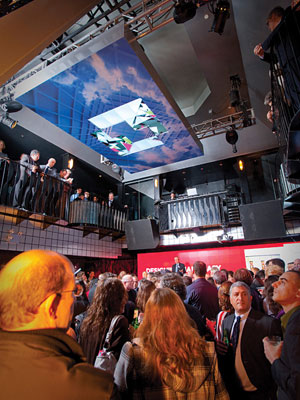Rear-Projection Tiled Digital Media Walls
Operation and Maintenance
While the technology is sophisticated behind rear-projection tiled digital displays, they are easy to operate. The output of content or messaging from a PC or media player runs into a small external control unit (ECU), which drives the tiled modular units. The tiles stack and join like blocks with screws, standard line and power cords. Unlike LED displays, tiled LCD or plasma flat-panel display walls, rear-projection tiled digital displays automatically calibrate in seconds on initial set-up and continuously auto-calibrate for color and brightness to ensure a harmonious display across the digital media wall for the entire life of the display, without any need for technicians to adjust controls.
Rear-projection tiled digital display units consist of four easy-to-replace service modules: the screen, light engine, power supply, and fans. All components are readily accessed from the front of the unit, since the screen is instantly removed using a suction cup, and can be replaced within 15 minutes by facilities personnel. This eliminates significant display downtime and the inconvenience of calling technical service people to repair and replace the units.
 |
Rear-projection tiled digital displays can be ceiling-mounted, as shown, as well as wall-, angle- and floor-mounted, demonstrating flexibility of orientation and location. Photo by Christie® |
Even if a display operates around the clock, the likelihood of screen burn-in, where an image is permanently seared onto a screen, is eliminated with rear-projection tiled digital displays. Unlike LCD and phosphor-based displays, rear-projection tiled digital displays can show any static or moving content continuously, with no chance of images burning permanently into the screen.
The LEDs in high-performance rear-projection digital display tiles have an average lifespan of 65,000 hours to 50 percent brightness, resulting in about seven and a half years of continuous use before the images begin to degrade in quality. This performance is equal to or better than most alternative technologies. Longer life cycle of a component means less need for replacement of parts and servicing.
Some displays can be heavy, with glass screens that are easily broken, costly and difficult to replace. Rear-projection tiled digital display screens are lightweight, durable, and robust, reducing the need to replace screens frequently. Screens are made from shatter-resistant acrylic, and are ideal for displays in high-traffic public areas.
Integration
Walls of LCD and plasma monitors, or stacked and joined LED screens, must be carefully and regularly calibrated so that all units match colors, brightness, and contrast. However, rear-projection tiled digital displays are designed to automatically calibrate and balance colors within 15 seconds after being switched on. Thus, an array of tiles will always be uniform in brightness, color and contrast. While other display formats need routine maintenance and monitoring to maintain a uniform look, rear-projection tiled digital display processors synchronize automatically to produce consistent, high quality images.
Color Calibration
The light engine inside each rear-projection digital display tile contains three LEDs: red, green and blue. Sensors inside the light engine continuously monitor the temperature and maximum light output of each LED. Using this information, the external control unit is able to make adjustments to the color space and brightness of each individual tile, so the entire display is always matched.
One ECU can drive several hundred tiles. However, for most applications, a ratio of between six to thirty tiles per ECU is typical. Up to 64 ECUs can be connected together and control a single tiled digital display, which will ensure consistent color and brightness, and serve as a single video source for an entire wall, representing a cost savings. Adding ECUs allows several videos to play within one display wall.
Life-Cycle Costs
The total life-cycle cost of a digital display installation is an important factor for architects, owners and project teams as they review capital construction, equipment, and operational budgets. Initial purchase costs must be analyzed against the total operational and ownership costs over the anticipated product life cycle, which may be a 10-year planning horizon.
Rear-projection tiled digital display units will typically operate for about seven and a half years before the LEDs go to half brightness, based on continuous usage, thus minimizing replacement costs. Basic components, including the LED light engine, can be serviced from the front of the unit, not the back, as with other formats, because screens pop off. If one unit malfunctions, that unit can be repaired or replaced, rather than the entire display. Flat-panel screens typically have a short life cycle of two to three years when operating continuously. When one screen malfunctions, often the entire display wall must be replaced.
Issues to consider when evaluating life-cycle costs of digital displays include:
- Maintenance: frequency and costs of hardware replacement over the life of the product, ease of repair, replacement and servicing, warranty, downtime and inconvenience for repairs
- Labor costs for installation and routine maintenance; whether maintenance can be performed by facilities personnel or special technicians
- Energy consumption: average power consumption at maximum brightness, lifetime operating and cooling energy costs
- Salvage value at the end of the product’s useful life









